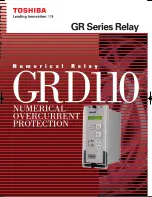
GE Multilin
L60 Line Phase Comparison System
8-1
8 THEORY OF OPERATION
8.1 OVERVIEW
8
8 THEORY OF OPERATION 8.1OVERVIEW
8.1.1 INTRODUCTION
Phase comparison relaying is a kind of differential relaying that compares the phase angles of currents entering one termi-
nal of a transmission line with the phase angles of the currents entering all remote terminals of the same line. For the con-
ditions of a fault within the protected zone (internal fault), the currents entering all the terminals will be in phase. For
conditions of a fault outside the zone of protection (external or through fault), or for load flow, the currents entering any one
terminal will be 180° out of phase with the currents entering at least one of the remote terminals. The phase comparison
relay scheme makes this phase angle comparison and trips the associated breakers for internal faults. Since the terminals
of a transmission line are normally many miles apart, some sort of communication channel between the terminals is
required to make this comparison.
8.1.2 FUNDAMENTAL PRINCIPLE OF PHASE COMPARISON
The basic operation of a phase comparison scheme requires that the phase angle of two or more currents be compared
with each other. In the case of transmission line protection, these currents may originate many miles from each other so, as
noted above, some form of communication channel is required as part of the scheme.
If a two-terminal line is considered (see figure below), the relays located at terminal A can measure the current at that ter-
minal directly. The phase angle of the current at the remote terminal (B) must somehow be communicated to terminal A.
Since the current sine wave is positive for ½-cycle and then negative for the next ½-cycle, it may be used to key a transmit-
ter first to a MARK signal for a half cycle and then to a SPACE signal for the next half cycle for as long as the current is
present. Such a signal transmitted at B and received at A can be compared with the current at A to determine whether the
two quantities are in phase or out of phase with each other. Conversely, the current at terminal B may be compared with the
signal received from terminal A.
Figure 8–1: PHASE ANGLE COMPARISON
Содержание UR series
Страница 2: ......
Страница 4: ......
Страница 12: ...xii L60 Line Phase Comparison System GE Multilin TABLE OF CONTENTS ...
Страница 32: ...1 20 L60 Line Phase Comparison System GE Multilin 1 5 USING THE RELAY 1 GETTING STARTED 1 ...
Страница 54: ...2 22 L60 Line Phase Comparison System GE Multilin 2 2 SPECIFICATIONS 2 PRODUCT DESCRIPTION 2 ...
Страница 132: ...4 30 L60 Line Phase Comparison System GE Multilin 4 3 FACEPLATE INTERFACE 4 HUMAN INTERFACES 4 ...
Страница 438: ...7 8 L60 Line Phase Comparison System GE Multilin 7 2 TARGETS 7 COMMANDS AND TARGETS 7 ...
Страница 478: ...8 40 L60 Line Phase Comparison System GE Multilin 8 3 FAULT LOCATOR 8 THEORY OF OPERATION 8 ...
Страница 502: ...A 10 L60 Line Phase Comparison System GE Multilin A 1 PARAMETER LIST APPENDIXA A ...
Страница 584: ...B 82 L60 Line Phase Comparison System GE Multilin B 4 MEMORY MAPPING APPENDIXB B ...
Страница 622: ...D 10 L60 Line Phase Comparison System GE Multilin D 1 PROTOCOL APPENDIXD D ...
Страница 634: ...E 12 L60 Line Phase Comparison System GE Multilin E 2 DNP POINT LISTS APPENDIXE E ...
Страница 642: ...F 8 L60 Line Phase Comparison System GE Multilin F 3 WARRANTY APPENDIXF F ...
















































